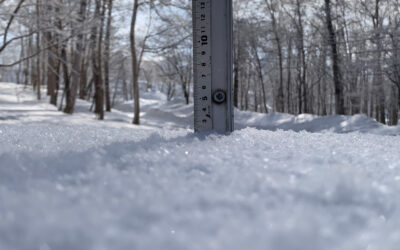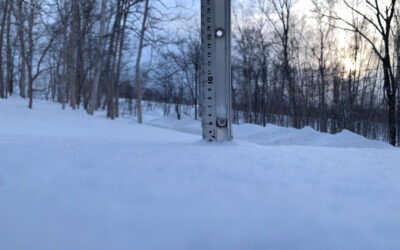I heard a guide once mention the following; ‘you don’t climb Yotei for the snowboarding’. There is also a famous Japanese saying; ‘you are wise to climb Mount Fuji once, and foolish to climb it twice’. After having climbed Mount Yotei twice in three days, I wonder if the same applies here.
Photos courtesy of Powdershots Niseko
Mount Yotei is an astonishing natural landmark, commanding attention on those marvellous clear days that are usually so rare during winter in Niseko. Factual tidbit – Mount Yotei was also called Ezo Fuji – “Ezo” being the old name for Hokkaido, and because it looks very similar to Mount Fuji, though about half the height. With it being so prominent and beautiful, it’s no wonder that so many people look out and dream of climbing it.
The easiest way of achieving this dream is to hire a guide. Experienced guides will know the best way to reach the summit, and just as important, the best way back down. They will also be able to advise about the weather conditions to know if it is possible (or worthwhile), as well as other important and variable factors like current avalanche risk. Guides will usually be able to help organise essential backcountry equipment such as avalanche transceivers, shovel, probe, and snowshoes/skins.
There are four main routes that people use to reach the summit of Mount Yotei, though the two most popular (from Niseko) are the west facing Hangetsuko and the south facing Makkari. Hangetsuko (Half Moon Lake) has the added bonus of offering stunning views back towards Niseko, so while everyone in Niseko is in awe and looking out at Mount Yotei, you are on Mount Yotei in awe looking back at Niseko.
The hike isn’t easy, taking roughly five hours (less if the group is fit, more if the group isn’t). At the same time, the hike isn’t too difficult – you don’t have to be an ironman triathlete.
The Hangetsuko route starts off quite easy, with a gentle stroll through a pine forest along the slowly rising foothills. However, things quickly get serious once out into the open. It is also the first opportunity to see just how far there is left to go.
The next few hours are spent in an almost constant climb up a consistent and steep gradient. Once you exit the shelter of the tree line at about 1200m, the snow can become quite icy from the wind, which can actually make the climb quite easy with a set of good snowshoes.
Then there is the boulder field, where giant boulder-sized lumps of snow and ice (from the buried shrubs/bushes) slow down progress. This is about the point that skiers start to have a hard time skinning and may have to resort to snowshoes or boot packing. The Hangetsuko trail also has a false summit, which will no doubt dishearten most people the first time they realise that they still have further to go.
But, eventually, after a lot of hiking, and if the weather is co-operative, you will be lucky enough to find yourself standing on the rim of a giant snowy volcano. All thoughts of fatigue and suffering will be erased, and a combination of euphoria and elation will sweep over you at the thought of skiing or snowboarding down into the caldera of Mount Yotei.
There is only approximately 150m of vertical, or just enough time for a dozen quick turns, before you find yourself standing in the middle of an enormous snowy bowl, and the grin will last until about half way of the walk back out. There is another fantastic 360 Niseko blog post about the crater with photos – here.
Now, here comes the part about ‘you don’t climb Yotei for the snowboarding’. The first part of the decent can require navigating through the same giant icy ‘boulders’ that slowed down the ascent. It can also tend to be hard and windblown from Mount Yotei being exposed and quite tall.
But, eventually the snow gets deeper in the protected valleys and the fun times begin. And, they keep on going for quite a while, which shouldn’t be surprising considering the effort used to reach the top. This is the high point, hundreds of vertical meters of potentially untracked snow down a steep and open slope – bliss.
Then you finally reach the lower section in the woodlands, where the snow can be quite hard, wet and sun baked, making for a sticky and less than awesome final leg back to the car park.
It’s right about now that the celebrations begin, with giant grinning faces and rounds of high-fives (and beer if the group was forward thinking enough).
So, apart from fitness, the main obstacle in reaching the summit is the weather. It generally considered not worth the effort if it is not going to be a clear and calm day. Mount Yotei is known for donning a hat of clouds, which understandably affects visibility – if you can’t see what you are doing, what is the point. Wind is also a major factor, being so high and exposed, wind speed is generally much higher making the hike up the hard and at times icy surface dangerous – not to mention uncomfortable.
Late February or early March is generally regarded as a good time to think about doing the hike, as there are more sunny days, less wind and fewer storms, though it is certainly possible at other times.
Advice: Hire a guide; understand how to use back country safety equipment; be prepared for bad weather – just because it’s sunny when you start out, doesn’t mean it will stay that way all day; take plenty of food and water (1.5L recommended minimum); take a spare set of goggles; take a hat/sunglasses and sunscreen; hire a guide.
It is an incredible experience to stand on the top of Mount Yotei and to look down into the crater. It isn’t easy, but it is worth every drop of sweat and every muscle pain.





















